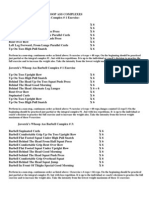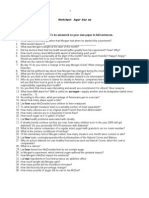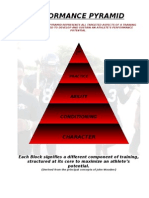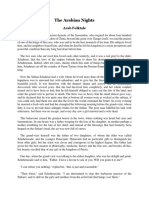ptq2.2 Incorporating Variety With Bulgarian Bags PDF
ptq2.2 Incorporating Variety With Bulgarian Bags PDF
Uploaded by
Endri HoxhajCopyright:
Available Formats
ptq2.2 Incorporating Variety With Bulgarian Bags PDF
ptq2.2 Incorporating Variety With Bulgarian Bags PDF
Uploaded by
Endri HoxhajOriginal Title
Copyright
Available Formats
Share this document
Did you find this document useful?
Is this content inappropriate?
Copyright:
Available Formats
ptq2.2 Incorporating Variety With Bulgarian Bags PDF
ptq2.2 Incorporating Variety With Bulgarian Bags PDF
Uploaded by
Endri HoxhajCopyright:
Available Formats
FEATURE ARTICLE
INCORPORATING VARIETY WITH BULGARIAN BAGS
BRIAN JONES, PHD, CSCS, NSCA-CPT, AND JULIE BOGGESS
P
ersonal trainers are required to constantly challenge LOWER BODY TRAINING
their clients physically and mentally. In order to retain Nearly any lower body training exercise, including squat and lunge
customers, trainers must improve or maintain their client’s variations, can be loaded effectively with the Bulgarian Bag. The
fitness levels while keeping them interested in the process. For crescent shape is ideal for front and back squats (Figures 1 and
this reason, incorporating variety into the training program 2). A client can perform squats, squat jumps, lunges, or step-ups
can be an invaluable tool. Research has found that a major just as they would when using other types of resistance or loads.
predictor of whether people continue to exercise is how much In addition, the front hold position (Figure 3) is excellent for
they enjoy it (1,7,9,13). Results simply are not enough motivation developing core stability and teaching clients to maintain a more
if they are not having fun. The Bulgarian Bags, developed upright trunk position.
by Bulgarian wrestling coach Ivan Ivanov, provide a unique
way to add interest to any client’s workout program (8,11). More dynamic total body work includes the swing and the swing
squat. The technique for the Bulgarian Bag swing (Figures 4 – 6)
These bags are similar to sandbags and have many of the same is much the same as for the kettlebell swing, but with a wider
benefits, but the unique shape allows for the performance stance to allow the bag to clear the knees. The swing exercise
of some movements that are difficult to perform with most may be useful in helping to develop hip and core strength, power,
weighted bags (2,4,10). The unique shape of the bag combined and endurance. Only advanced clients should perform the swing
with the different grips and handles make it an extremely squat (Figures 7 – 9). To start the exercise, the client should grip
versatile tool. It allows for many different rotational exercises the bag by bringing the handles together. They should swing the
that are often not possible with other exercise equipment. bag between the legs while extending the knees, then they should
The bags are portable enough for travel workouts and ideal drive the bag forward using the hips while descending into a
for personal trainers who travel to their clients’ homes. squat. Maximal depth in the squat should occur just as the arms
and bag are parallel with the floor.
Many of the same movement patterns popular in kettlebell
training can be done with the Bulgarian Bags. This means that UPPER BODY TRAINING
clients can learn proper kettlebell movement patterns using Nearly any upper body barbell or dumbbell exercise can also
the Bulgarian Bags with less potential injury risk and the bags be performed with the Bulgarian Bag, including presses, rows
may be less intimidating than kettlebells for some people. (Figures 10 and 11), and cleans. The different handles allow a
Currently, there is no direct research on the effectiveness of variety of single and double handed grips for both unilateral and
the Bulgarian Bags, but several studies have found similar bilateral training. Additionally, two bags can be used by having
training with kettlebells to be effective for developing one held in each hand.
strength, power, and cardiovascular endurance (1,3,5,6,12).
34 PTQ 2.2 | NSCA.COM
Push presses (Figures 12 and 13), jerks (Figures 14 and 15), high REFERENCES
pulls, and snatches can be performed with the Bulgarian Bags 1. Beardsley, C, and Contreras, B. The role of kettlebells in
as well. These exercises teach power transfer from the lower to strength and conditioning: A review of the literature. Strength and
the upper body and are an efficient means of total body training. Conditioning Journal 36(4): 64-70, 2014.
With higher repetition sets, full body exercises such as the push
2. Hozub, FM. Using sandbags to improve strength in middle
press, jerk, and thruster can act as effective conditioning training
school students. Journal of Physical Education, Recreation, and
exercises.
Dance 80(7): 12, 2009.
CORE WORK 3. Hulsey, CR, Soto, DT, Koch, AJ, and Mayhew, JL. Comparison
All of the standing exercises previously described create a strong of kettlebell swings and treadmill running at equivalent rating
training stimulus for core stability. More direct core work can of perceived exertion values. The Journal of Strength and
include weighted sit-ups, side bends, Russian twists (Figures 16 Conditioning Research 26(5): 1203-1207, 2012.
and 17), and the more advanced Bulgarian Bag spin exercise. The
4. Jones, B. The Complete Sandbag Training Course. Nevada City,
Bulgarian Bag spin (Figures 18 – 22) exercise involves a strong
CA: Ironmind Enterprises; 2004.
rotation with the core as the arms lock the bag into position.
The client should pivot using the hips and move the bag in a 5. Lake, JP, and Lauder, MA. Kettlebell swing training improves
circular motion around the head keeping the spine fairly neutral maximal and explosive strength. The Journal of Strength and
throughout. The client should perform equal work in both Conditioning Research 26(8): 2228-2233, 2012.
directions to ensure even development. 6. Lake, JP, and Lauder, MA. Mechanical demands of kettlebell
swing exercise. The Journal of Strength and Conditioning Research
WORK CAPACITY EXERCISES
26(12): 3209-3216, 2012.
These bags can also be useful for performing “finisher” exercises
that come after the primary exercises are completed. Finishers 7. Ranieri, MJ. Client motivation: Part 2. Strength and
should involve the whole body and can be incorporated into the Conditioning Journal 23(6): 68-69, 2001.
program during higher intensity days or when the client wants to 8. Sava Sport. The Bulgarian Bag I – History. Retrieved February
push themselves harder at the end of a workout. Finisher exercises 2015 from http://www.savasport.com/35-the-bulgarian-bag-i-
can be done for a certain number of sets or timed intervals. history/.
Two excellent finisher exercises are bag slams and bag throws. 9. Seguin, RA, Economos, CD, Palombo, R, Hyatt, R, Kruder,
To perform Bulgarian Bag slams (Figures 23 - 26), use a heavy J, and Nelson, ME. Strength training and older women: A cross-
bag, tire, or other rebounding surface to slam the bag onto. The sectional study examining factors related to exercise adherence.
client should hit the surface as hard as they can with the Bulgarian Journal of Aging and Physical Activity 18(2): 201-218, 2010.
Bag by using a coordinated upper and lower body effort. As it 10. Sell, K, Taveras, K, and Ghigiarelli, J. Sandbag training: A
rebounds, the client should have the bag circle around their head sample 4-week training program. Strength and Conditioning
and come to rest in the starting position. Journal 33(4): 88-96, 2011.
There are a number of different ways to throw a Bulgarian Bag, for 11. Suples Training Systems. History. Retrieved February 2015
example: push throw, underhanded throw forward, twisting throw from http://suples.com/bulgarian-bag/.
to the side, or overhead backward throw. The client could throw 12. Thomas, JF, Larson, KL, Hollander, DB, and Kraemer, RR.
the Bulgarian Bag for maximal distance with good form, walk or Comparison of two-hand kettlebell exercise and graded treadmill
run to the bag, and then repeat. Using either repetitions or time walking: Effectiveness as a stimulus for cardiorespiratory fitness.
intervals work well for Bulgarian Bag throws. The Journal of Strength and Conditioning Research 24(4): 998-
1006, 2014.
PROGRAMING
Bulgarian Bags can be used as a stand-alone training tool as 13. Weiss, WM, and Halupnik, D. Commitment to strength and
they are made in weights ranging from 6 – 85 lb. They also make conditioning: A sport commitment model perspective. The Journal
excellent additions to existing training programs that utilize of Strength and Conditioning Research 27(3): 718-722, 2013.
more traditional methods. Table 1 provides a sample workout for
a client using only Bulgarian Bags and bodyweight resistance
exercises. The repetition ranges listed are basic guidelines and
sets should continue only as long as the client can maintain proper
form. Table 2 demonstrates how the Bulgarian Bag exercises can
be incorporated into a weekly strength training program. For
this routine, the Bulgarian Bag exercises are prescribed in time
intervals with the goal of muscular endurance and metabolic
conditioning.
PTQ 2.2 | NSCA.COM 35
INCORPORATING VARIETY WITH BULGARIAN BAGS
Julie Boggess is President and Head Coach of the Louisville
Kettlebell Club in Louisville, KY. She is a certified kettlebell and
ABOUT THE AUTHOR
Bulgarian Bag instructor, and a Kettlebell Sport competitor in which
Brian Jones is an Assistant Professor of Exercise Science in the
she earned the title of Candidate Master of Sport in 2014. Boggess
department of Kinesiology and Health Studies at Georgetown
is a life-long athlete, having played scholastic softball and field
College in Kentucky. He has worked as a strength coach for several
hockey, and currently maintains a 4.0 rating by the United States
different D-I athletic teams at the University of Kentucky and has
Tennis Association. Her clients include active competitors and
strength coaching experience with high school and professional
those just interested in improving general fitness. Boggess enjoys
athletes. Jones has authored three books, two book chapters,
working with clients of all backgrounds and abilities to bring out
and numerous articles on strength training, supplementation, and
their best.
other exercise science topics. Jones has served as the NSCA State
Director for Kentucky and currently sits on the Advisory Board
for Kentucky and the Great Lakes Region. He has a 2nd degree
black belt in Brazilian jiu-jitsu and is the owner and head coach of
Valhalla Academy, a jiu-jitsu school in Frankfort, KY.
FIGURE 1. BULGARIAN BAG BACK SQUAT – START FIGURE 2. BULGARIAN BAG BACK SQUAT – FINISH
FIGURE 3. BULGARIAN BAG FRONT FIGURE 4. BULGARIAN BAG SWING –
HOLD POSITION BOTTOM OF SWING
36 PTQ 2.2 | NSCA.COM
NSCA.com
FIGURE 5. BULGARIAN BAG SWING – FIGURE 6. BULGARIAN BAG SWING – TOP
MIDDLE OF SWING OF SWING
FIGURE 7. BULGARIAN BAG SWING SQUAT – FIGURE 8. BULGARIAN BAG SWING SQUAT –
BOTTOM OF SWING MIDDLE OF SWING
FIGURE 9. BULGARIAN BAG SWING SQUAT – TOP
OF SWING WITH SQUAT
PTQ 2.2 | NSCA.COM 37
INCORPORATING VARIETY WITH BULGARIAN BAGS
FIGURE 10. BULGARIAN BAG ROW – START FIGURE 11. BULGARIAN BAG
ROW – FINISH
FIGURE 12. BULGARIAN BAG PUSH FIGURE 13. BULGARIAN BAG PUSH
PRESS – START PRESS – FINISH
FIGURE 14. BULGARIAN BAG FIGURE 15. BULGARIAN BAG
JERK – START JERK – FINISH
38 PTQ 2.2 | NSCA.COM
NSCA.com
FIGURE 16. BULGARIAN BAG RUSSIAN FIGURE 17. BULGARIAN BAG RUSSIAN
TWIST - RIGHT TWIST - LEFT
FIGURE 18. BULGARIAN BAG SPIN FIGURE 19. BULGARIAN BAG SPIN
FIGURE 20. BULGARIAN BAG SPIN FIGURE 21. BULGARIAN BAG SPIN
PTQ 2.2 | NSCA.COM 39
INCORPORATING VARIETY WITH BULGARIAN BAGS
FIGURE 22. BULGARIAN BAG SPIN FIGURE 23. BULGARIAN BAG SLAM
FIGURE 24. BULGARIAN BAG SLAM
FIGURE 25. BULGARIAN BAG SLAM
FIGURE 26. BULGARIAN BAG SLAM
40 PTQ 2.2 | NSCA.COM
NSCA.com
TABLE 1. SAMPLE BULGARIAN BAG PROGRAM
MONDAY TUESDAY WEDNESDAY THURSDAY FRIDAY
Joint mobility warm-up Rest and mobility work Joint mobility warm-up Rest and mobility work Joint mobility warm-up
“Basic bag protocol” (4 Tabata circuit (8 rounds “The 500” (4 sets: 1st set
sets or for time) per exercise; 20 s work x 10 reps per exercise,
and 10 s rest) rest 1 min 2nd set x 20 reps, 3rd
• 10 spins (both between exercises x 15 reps, and 4th x 10
sides) reps)
• Alternating front
• 10 snatches lunge (bag on • Spins
shoulders)
• 10 shoulder • Swing snatch
throws (both • Snatch
sides) • Romanian
• Overhead press deadlifts
• 10 push-ups
• Straight-arm front • Side bends
raise
• Jumping split
• Front squat squats
• Triceps extension • Front raise
• Halos
• Triceps extensions
• Hammer curls
• Push-ups
*Maintain a consistent repetition count for each time interval
PTQ 2.2 | NSCA.COM 41
INCORPORATING VARIETY WITH BULGARIAN BAGS
TABLE 2. SAMPLE BULGARIAN BAG PROGRAM TO INCORPORATE WITH RESISTANCE TRAINING
MONDAY TUESDAY WEDNESDAY THURSDAY FRIDAY
Warm-up Warm-up Rest Warm-up Warm-up
Back squat (5 x 5 reps) Bench press (5 x 5 reps) Power clean (5 x 3 reps) Standing push press (5 x
5 reps)
Romanian deadlift (3 x Weighted pull-ups (5 x Front squat (5 x 5 reps)
8 reps) 6 – 8 reps) Row (5 x 10 reps)
Hanging leg raise (5 x
Weighted sit-ups (5 x Neck work max reps) Neck work
10-15 reps)
Bulgarian Bag routine Bulgarian Bag track Bulgarian Bag circuit (3
Bulgarian Bag circuit (3 (minimal rest) circuit (minimal rest) x 5 min with 1 min rest;
rounds with 1 min rest) max rounds for time)
• Snatch (x 20) • Carry bag while
• Squat swings (x jogging (2 rounds • Jerk (x 10)
20) • Bag slams (x 20) with 2 min rest
between rounds) • Front squat (x 10)
• Spins (x 10 each • Thrusters (x 20)
way) • Swings (x 20) • Overhead throw
• Russian twist (x (x 5)
• Forward push 20) • 200-m walk/jog
throw (x 10) • Underhand throw
• Turkish get-ups (x • Burpees with bag (x 5)
10 each side) (x 10)
• 200-m walk/jog
• Bag rows (x 20)
• 200-m walk/jog
• Triceps extensions
(x 20)
• 200-m walk/jog
42 PTQ 2.2 | NSCA.COM
You might also like
- TRAINING FOR GOLD: The plan that made Daniel Ståhl Olympic ChampionFrom EverandTRAINING FOR GOLD: The plan that made Daniel Ståhl Olympic ChampionNo ratings yet
- Westside 4 Skinny BastardsDocument4 pagesWestside 4 Skinny BastardsFedesune100% (1)
- NIKE-The Program ForwardsDocument20 pagesNIKE-The Program ForwardsCharlotteEng100% (1)
- Off Season Program.01Document11 pagesOff Season Program.01Youssef Mehrez100% (1)
- Kicking DrillsDocument8 pagesKicking Drillsgmagic45032No ratings yet
- 2011 NSU Football Summer Program ManualDocument30 pages2011 NSU Football Summer Program ManualmunichrangersNo ratings yet
- Big Cats Part 1Document9 pagesBig Cats Part 1CoachmalloryNo ratings yet
- Whoop Ass FBDocument1 pageWhoop Ass FBrajkumarvpost6508No ratings yet
- The 25% - 75% Rule Year-Round Training With Discipline and ToughnessDocument5 pagesThe 25% - 75% Rule Year-Round Training With Discipline and ToughnessSBD4lifeNo ratings yet
- Big Cats Part 2 PDFDocument6 pagesBig Cats Part 2 PDFCoachmalloryNo ratings yet
- System Strength ManualDocument76 pagesSystem Strength ManualRyan McGovernNo ratings yet
- 2013 LSU Coaching Clinic Notes PDFDocument4 pages2013 LSU Coaching Clinic Notes PDFthrowtherockNo ratings yet
- Big Cats Part 3Document5 pagesBig Cats Part 3Coachmallory100% (1)
- Organizing A High School Weight RoomDocument72 pagesOrganizing A High School Weight Roommalloryc100% (1)
- The Set-Rep BibleDocument6 pagesThe Set-Rep Biblezedrijnali100% (1)
- 2011 Strength and Conditioning Program Outline PDFDocument13 pages2011 Strength and Conditioning Program Outline PDFtheshow31No ratings yet
- Off Season Strength Program Week 1-3Document1 pageOff Season Strength Program Week 1-3Tyler WriceNo ratings yet
- Westside Conjugate CalculatorDocument10 pagesWestside Conjugate Calculatorp300644No ratings yet
- General Preparatory Classifications For Division 1 FootballDocument8 pagesGeneral Preparatory Classifications For Division 1 Footballxceelent100% (3)
- MacMurray Football Post Season WorkoutsDocument18 pagesMacMurray Football Post Season Workoutsmartiny67No ratings yet
- Strength Training For LinemenDocument23 pagesStrength Training For LinemenJeff Cziska100% (2)
- CFGB GPP Programming Strength Cycles PDFDocument1 pageCFGB GPP Programming Strength Cycles PDFAntonio ValentinoNo ratings yet
- Fitness Corner091902 PDFDocument39 pagesFitness Corner091902 PDFlackcreatvtyNo ratings yet
- Coach-1 - Skills-And-Key-Teaching-Points-EDocument34 pagesCoach-1 - Skills-And-Key-Teaching-Points-EflorisjanroelofNo ratings yet
- The Anatomy and Physiology of Blocking Kicks - AFCA InsiderDocument8 pagesThe Anatomy and Physiology of Blocking Kicks - AFCA InsiderULTIMATE FOOTBALL UNIVERSITYNo ratings yet
- Strength and Conditioning Practices of National Basketball Association Strength and Conditioning CoachesDocument10 pagesStrength and Conditioning Practices of National Basketball Association Strength and Conditioning CoachesJaron KungNo ratings yet
- Max Sheet Break Down Final 2 Test Back SquatDocument3 pagesMax Sheet Break Down Final 2 Test Back SquatRichard Marcus SeigelNo ratings yet
- Worksheet: Super Size MeDocument1 pageWorksheet: Super Size Mecarlosr29No ratings yet
- Dreher Strength ProgramDocument240 pagesDreher Strength ProgramAlfredo QuinonesNo ratings yet
- Bill Starr 5x5 - Madcow Intermediate or Linear VersionDocument8 pagesBill Starr 5x5 - Madcow Intermediate or Linear VersionzarpadolimadoNo ratings yet
- BC Summer StrengthDocument59 pagesBC Summer Strengththeshow31No ratings yet
- Strength and Conditioning PhilosophyDocument3 pagesStrength and Conditioning PhilosophyJosh BargeNo ratings yet
- Batting Drills: Self Toss DrillDocument17 pagesBatting Drills: Self Toss Drillbarry simmonsNo ratings yet
- Morgan Academy StrengthDocument17 pagesMorgan Academy StrengthRyan McGovernNo ratings yet
- Tony Ciraelli - Training Throwers To Peak PerformanceDocument9 pagesTony Ciraelli - Training Throwers To Peak Performancebigman9100% (1)
- Increase Vertical JumpDocument8 pagesIncrease Vertical JumpShane Staten0% (1)
- Eureka College Summer ManualDocument96 pagesEureka College Summer Manualcoach bNo ratings yet
- BFS Readiness Program: Tuesday (Day 1) Thursday (Day 2)Document1 pageBFS Readiness Program: Tuesday (Day 1) Thursday (Day 2)Thomas GrimmNo ratings yet
- Workout - Sheet - Football Clean and Jerk ProgramDocument6 pagesWorkout - Sheet - Football Clean and Jerk ProgramTom HochhalterNo ratings yet
- 2018 WHS S&C ManualDocument61 pages2018 WHS S&C Manualeric struckNo ratings yet
- Football Strength & SpeedDocument2 pagesFootball Strength & SpeedTom HochhalterNo ratings yet
- Teaching The Power CleanDocument54 pagesTeaching The Power CleanStu Skalla GrimsonNo ratings yet
- Crossfit NorCal - The Performance Menu Issue 5Document12 pagesCrossfit NorCal - The Performance Menu Issue 5Anil OrhanNo ratings yet
- 729454Document14 pages729454munichrangersNo ratings yet
- Boyd Epley Testing and Evaluation Mod 1Document36 pagesBoyd Epley Testing and Evaluation Mod 1Jay Mike100% (1)
- Herman Edwards, Shelly Smith You Play To Win The Game LeadershipDocument215 pagesHerman Edwards, Shelly Smith You Play To Win The Game Leadershiphernanmcuni100% (1)
- 3 Letter From Coach To TeamDocument6 pages3 Letter From Coach To TeamCoach Joe Bouffard100% (1)
- Sport Ed Model - Spikeball 1Document36 pagesSport Ed Model - Spikeball 1api-310301607No ratings yet
- Football Performance Pyramid of SuccessDocument6 pagesFootball Performance Pyramid of SuccessJeamillio Lewis100% (4)
- Terrier Football Strength and Conditioning Summer ManualDocument28 pagesTerrier Football Strength and Conditioning Summer Manualcoachowens68100% (1)
- Building The Raw Bench PressDocument4 pagesBuilding The Raw Bench PressMartin BeastallNo ratings yet
- Dan Mortier Head Football Coach New Trier High School 847-784-2220Document21 pagesDan Mortier Head Football Coach New Trier High School 847-784-2220pass46No ratings yet
- Implementing The Inside Zone Running GameDocument64 pagesImplementing The Inside Zone Running Gamegrid44No ratings yet
- Specific Strength, Flexibility, Balance For The Discus ThrowDocument15 pagesSpecific Strength, Flexibility, Balance For The Discus ThrowAngelo PosillicoNo ratings yet
- 2010 Notre Dame ClinicDocument19 pages2010 Notre Dame ClinicJustin WanzekNo ratings yet
- Running Against The Odds: An Inspirational Journey to Making High School Sports HistoryFrom EverandRunning Against The Odds: An Inspirational Journey to Making High School Sports HistoryNo ratings yet
- The QB Mentor: Words of Wisdom From an NFL Veteran For An Injured Quarterback That Can Improve Your Life and CareerFrom EverandThe QB Mentor: Words of Wisdom From an NFL Veteran For An Injured Quarterback That Can Improve Your Life and CareerNo ratings yet
- High Performance Sport Skill Instruction, Training, and Coaching. 9 Powerful Principles for Athletes to Flow and Get in the ZoneFrom EverandHigh Performance Sport Skill Instruction, Training, and Coaching. 9 Powerful Principles for Athletes to Flow and Get in the ZoneNo ratings yet
- Producing and Leveraging Online Map Uncertainty in Trajectory PredictionDocument14 pagesProducing and Leveraging Online Map Uncertainty in Trajectory PredictionTwinNo ratings yet
- Brochure Masterlife - SraDocument6 pagesBrochure Masterlife - SraДанило ГадайчукNo ratings yet
- Physiology U-3 Excitable Nervous TissueDocument122 pagesPhysiology U-3 Excitable Nervous Tissuesinte beyuNo ratings yet
- PSY 310 REV MWA-WPS OfficeDocument13 pagesPSY 310 REV MWA-WPS OfficeandrewwanjjaNo ratings yet
- Experiment #4 Discharge Through An Orifice MeterDocument6 pagesExperiment #4 Discharge Through An Orifice MeterEddy KimathiNo ratings yet
- How To Become A Radio Amateur - 1932Document30 pagesHow To Become A Radio Amateur - 1932Victor AsterdamNo ratings yet
- Collisionless Energy Transfer in Kinetic Turbulence: Field-Particle Correlations in Fourier SpaceDocument31 pagesCollisionless Energy Transfer in Kinetic Turbulence: Field-Particle Correlations in Fourier SpaceAnindya BiswasNo ratings yet
- Klay2 Somera CaseDocument2 pagesKlay2 Somera CaseHoneybell Dela CruzNo ratings yet
- Culture and Education in Josef Pieper S PDFDocument8 pagesCulture and Education in Josef Pieper S PDFducadeliaNo ratings yet
- ACRMV - FundamentalDesignConceptDocument230 pagesACRMV - FundamentalDesignConceptannaaisyNo ratings yet
- The Arabian NightsDocument6 pagesThe Arabian NightsValeryNo ratings yet
- W.S. Anglin - Mathematics - A Concise History and PhilosophyDocument272 pagesW.S. Anglin - Mathematics - A Concise History and Philosophyclasesunisucre.danielNo ratings yet
- Modeling & Simulation: An Introduction To Business Process SimulationDocument24 pagesModeling & Simulation: An Introduction To Business Process SimulationNOSHEEN MEHFOOZNo ratings yet
- 253. Giáo Trình Tiếng Anh Chuyên Ngành Điện - Điện TửDocument165 pages253. Giáo Trình Tiếng Anh Chuyên Ngành Điện - Điện TửThai Phan Tan HoangNo ratings yet
- Edarabia ADEC Al Hamdanya Grand Private School 2015 2016 PDFDocument16 pagesEdarabia ADEC Al Hamdanya Grand Private School 2015 2016 PDFEdarabia.comNo ratings yet
- Centria-Super Rib-Tech Data SheetDocument2 pagesCentria-Super Rib-Tech Data SheetwipiriNo ratings yet
- VPVRDocument3 pagesVPVRAndrei PravăţNo ratings yet
- (GROUP 1 - BSN 2-YA-8) - Group DevelopmentDocument4 pages(GROUP 1 - BSN 2-YA-8) - Group DevelopmentDane Yron VIcenteNo ratings yet
- IPPB Recruitment 2024 54 ExecutivesDocument11 pagesIPPB Recruitment 2024 54 ExecutivesNikhil Ranjan PandeyNo ratings yet
- AsusDocument16 pagesAsusAceeNo ratings yet
- Week 2Document24 pagesWeek 27x6t2v4j6xNo ratings yet
- ĐÁP ÁN BÀI ĐỌCDocument15 pagesĐÁP ÁN BÀI ĐỌCMy Nguyễn Thạc TràNo ratings yet
- Computation Mumbai Bazaar 2022Document3 pagesComputation Mumbai Bazaar 2022Sanjeev RanjanNo ratings yet
- PMMA - SynthesisDocument8 pagesPMMA - Synthesiscuongtran_siegenNo ratings yet
- Pathway 37Document25 pagesPathway 37sr.mushtaq1No ratings yet
- Rajpal Singh: Objective ExperienceDocument2 pagesRajpal Singh: Objective Experiencerajpal kainturaNo ratings yet
- 00 Chrome PlatingDocument13 pages00 Chrome PlatingSuraj Rawat100% (1)
- B.A. (Hons.) : English Semester-IIIDocument29 pagesB.A. (Hons.) : English Semester-IIIRohanChoudharyNo ratings yet
- Dh-2023-March 12Document6 pagesDh-2023-March 12tqmvn859ssNo ratings yet
- TNPSC TopicDocument11 pagesTNPSC TopicM PraveenNo ratings yet

























































































